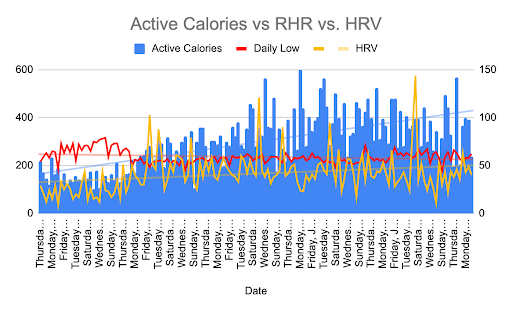Call Us
by Melissa Seifried
Long COVID Rehabilition Physiotherapist MScPT
updated Sept 15, 2023
You are likely reading this because you are either interested in our Long COVID rehabilitation program or your Physiotherapist has recommended you purchase a device for the purpose of monitoring key biometric health data. In this blog post, I will elaborate on the purpose behind data monitoring in Long COVID rehabilitation and how to choose a device that best suits your individual needs.
Purpose of Data Monitoring
There are 3 main reasons why we recommend that our patients obtain a wearable activity / heart rate tracker device:
1. Surveillance
These devices are gathering data throughout the day regardless if you engage with the technology or not. We recommend wearing the device 24/7 except to charge. Sleep data is incredibly valuable to evaluate the state of the autonomic nervous system and can inform decisions around how you pace while awake. We look for positive data trends indicating tolerance to current level of activity or signs of stress or negative data trends indicating impending episodes of symptom exacerbations (PEM).
2. Pacing
Energy conservation and activity modification are arguably the most fundamental aspects of Long COVID rehabilitation. We can leverage the technology embedded in wearable devices to make very specific recommendations around pacing depending on the clinical syndrome(s) the individual presents with. We can recommend pacing things like:
a. Total Activity: active calorie budget, step count budget
b. Activity Intensity: daily max heart rate (with or without notification)
c. Positioning: time spent in certain positions (i.e. upright or recumbent positions)- this is especially useful in POTS
3. Exercise/Activity Prescription
Having a device with a screen that can give you real time continuous heart rate readings is extremely valuable in the context of autonomic reconditioning and structured exercise. When your Physiotherapist believes you are ready to engage in monitored activity, they can make very specific recommendations (i.e. 10 mins of recumbent cycling at a heart rate of 120 bpm every 2 days or as symptoms permit). Your Physiotherapist may also recommend the use of an HRV based biofeedback device called Inner Balance by HeartMath.
Key Metrics We Are Interested In
When deciding on a device that is right for you, consider looking at the individual specifications of the device to ensure it measures all or most of the following metrics:
- Resting Heart Rate (RHR)*
- Heart Rate Variability (HRV)*
- Daily Max Heart Rate*
- Daily Active Calories*
- Daily Steps
- Sleep duration
- 2 min. heart rate recovery index
- Daily symptom rating scale
*Starred metrics are considered the most valuable
Below you will find an example of a graph your Physiotherapist can create with just a few months of data. Here you can see this individual’s activity has increased consistently while their resting heart rate (daily low bpm) trend has stabilized and their HRV has trended up. This indicates to us that this individual is tolerating higher levels of exertion due to the favourable positive trends in their RHR and HRV.
Things We Cannot Measure in Biometric Data
- Effect of cognition – cognitive exertion is equivalent to physical exertion in the context of triggering or worsening Long COVID symptoms and cannot be measured by typical activity metrics like active calories burned or a step count
- Effect of hydration/nutrition on symptoms and recovery
- Effect of anxiety and depression on symptoms and recovery
- Other sources of stress
Data is a canary in the mine. It can tell us to slow down to avoid a crash or PEM. It does not predict what a person is capable of tolerating in the future.
Optimizing Data Collection
As previously stated, we recommend all individuals participating in Long COVID physiotherapy obtain and wear a device that measures all or most of the previously stated metrics. Wearing your device 24/7 is the best way to get the most accurate readings and insights from your biometric data. We recommend taking off your device to charge once a day, ideally when you are resting or showering. Make sure you have a full or almost full charge at bedtime to ensure it will collect data for the entire night.
Wrist Devices vs. Chest Straps
We often get questions around the benefits of having a wrist wearable vs. a chest strap heart rate monitor. It is true that chest straps are considered to have higher quality heart rate sensors. However, a chest strap lacks the ability to display immediate heart rate feedback like a watch with a screen can. If the chest strap has an associated app, you may be able to find real time HR monitoring within that app but this will require you to have your phone handy and visible when engaging in conditioning.
Device Brand Recommendations
I’m sure it is not surprising to hear that not all devices are created equal and we do prefer some brands over others. Here I will outline key points when considering the most common wearable tech brands that will aim to help guide your decision making:
- Apple – Apple Watches are the #1 recommended brand of wearable device in our rehabilitation program currently. This is due to the fact that they are simple/ easy to use devices that are compatible with iPhones and other Apple products. Additionally, we recommend the use of an associated app called HeartWatch that organizes the data from Apple Health into useful categories and can be exported easily prior to each appointment with your Physiotherapist directly from your phone.
- Garmin – Garmin watches arguably have superior sensors to the Apple Watch but there is currently no easy way to consolidate and export data easily. Thus we typically recommend giving login access to your Garmin Connect account to your Physiotherapist so they can login at the time of your appointment and review different data trends with you. Alternatively, your Physiotherapist can set up a shared document and coach you on how to locate desired data and input it into a chart if you are not comfortable sharing your account credentials.
- Polar – Polar watches are on the pricier side but their sensors are very high quality. You can register your device (watch or strap) with Polar GoFit which will allow you to share your data easily with your Physiotherapist.
- Oura Ring – Oura Rings are devices that you wear daily on your desired finger that gather health data like heart rate, activity calories, HRV, sleep and stress. The main drawback of these devices is the inability to track activity and heart rate in real time.
- WHOOP Strap – Like Garmin, you can provide your Physiotherapist with your WHOOP strap login information to review data trends together.
You may have noticed that FitBit was not included in this list of recommended brands. The reason for this is a recent shift that connects FitBit with Google. Anyone purchasing a new FitBit device has to register with a Google account meaning that in order to share your data with your Physiotherapist, you will need to give them your Google Account login credentials. Like with Garmin, you can ask your Physiotherapist to create a shared document and coach you on how to locate desired data in your FitBit/Google account and input it manually.
Non-Wearable Options
If you are still unsure about obtaining a wearable device after reading this blog post, I get it! There are apps your Physiotherapist can recommend to gain some additional insight into your condition. The drawback to using apps over wearables is that you have to remember to engage with the app on a daily basis (and sometimes multiple times throughout the day) and we are not able to use this technology to aid returning to exercise or creating an activity budget for pacing purposes.
Visible
This app was created by and for individuals with Long COVID and ME/CFS. It requires the user to perform a daily RHR and HRV reading first thing every morning using the camera on a smartphone (before getting out of bed) as well as daily symptom rating in the evening before falling asleep. After 3 or so days of data collection, the app will begin to give you a Morning Stability score that will help guide decisions around pacing and activity modification for that day.
WellTory
This app allows you to upload/sync data from a compatible device in order to organize and view your data trends easily. Its primary use is for HRV monitoring much like the Visible app but you can do readings at any point throughout the day. You can also input additional data around stress, mental health, sleep, nutrition and hydration.
If you still have questions about the use of technology and data monitoring in Long COVID Physiotherapy, please reach out to your Physiotherapist or me at [email protected]. While use of technology in health can be overwhelming, we are here to make the process easier for you and help you learn what all those numbers mean.

Questions? We're happy to help!
Choosing the right service provider can be a big decision. We’re dedicated to answering any questions you have to help you make the best choice. Contact us today and ask us anything!
Call us at (416) 238-6749



